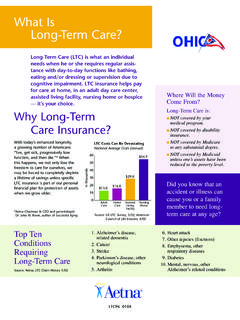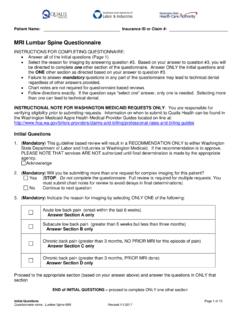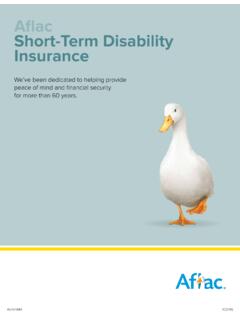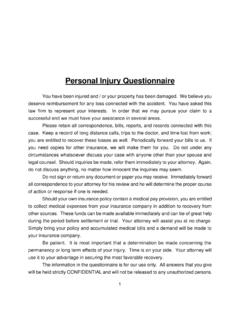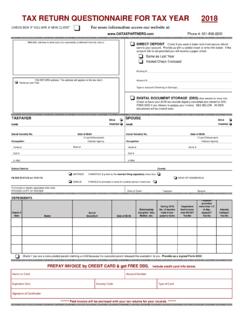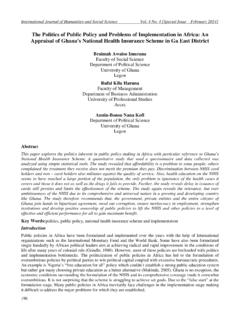Transcription of OECD HEALTH CARE QUALITY REVIEW: KOREA
1 OECD HEALTH care QUALITY review : KOREA ASSESSMENT AND RECOMMENDATIONS 27 February 2012 HEALTH Division Directorate for Employment, Labour and Social Affairs 2 FOREWORD HEALTH care QUALITY IN KOREA Foreword This report is the first of a new series of publications reviewing the QUALITY of HEALTH care across selected OECD countries. As HEALTH costs continue to climb, policy makers increasingly face the challenge of ensuring that substantial spending on HEALTH is delivering value for money. At the same time, concerns about patients occasionally receiving poor QUALITY HEALTH care has led to demands for greater transparency and accountability.
2 Despite this, there is still considerable uncertainty over which policies work best in delivering HEALTH care that is safe, effective and provides a good patient experience, and which QUALITY -improvement strategies can help deliver the best care at the least cost. OECD HEALTH care QUALITY Reviews seek to highlight and support the development of better policies to improve QUALITY in HEALTH care , to help ensure that the substantial resources devoted to HEALTH are being used effectively in supporting people to live healthier lives. KOREA is an ideal place to start this new series. Few countries have had as remarkable an expansion in HEALTH coverage over the past three decades.
3 That KOREA has achieved this at modest costs relative to other OECD countries is all the more remarkable. However, it is for the magnitude of its looming challenges an ageing population, rapidly rising costs and growing chronic disease burden that KOREA is now pursuing further reforms. The challenges that KOREA faces are common to many OECD countries, and will demand that policy makers re-orient HEALTH care to prioritise QUALITY while containing costs. This report seeks to provide constructive advice to further these efforts, informed by the experience of OECD countries at large. This report on KOREA was managed and coordinated by Ankit Kumar.
4 The other authors of this report are, in alphabetical order, Gerrard Abi-Aad, Y-Ling Chi and Niek Klazinga. The authors wish to thank John Martin, Stefano Scarpetta, Mark Pearson, Francesca Colombo and Michael Borowitz from the OECD Secretariat for their comments and suggestions. Thanks also go to Marl ne Mohier and Lucy Hulett for their tireless efforts on editing, and to Judy Zinemann for assistance. The completion of this report would not have been possible without the generous support of Korean authorities. This report has benefited from the expertise and material received from many HEALTH officials, HEALTH professionals, and HEALTH experts that the OECD review team met during a mission to KOREA in May 2011.
5 These included officials from different FOREWORD 3 HEALTH care QUALITY IN KOREA national offices and agencies, in particular: the Ministry of HEALTH and Welfare, the HEALTH Insurance review Agency (HIRA), the National HEALTH Insurance Corporation (NHIC) and National Evidence-based Healthcare Collaborating Agency (NEHCA). The authors would also like to express their gratitude to professional organisations such as the Korean Hospitals Association, the Korean Medical Association and the Korean Nursing Association; and to the many academics, HEALTH professionals and consumer representatives that shared their perspectives on improving QUALITY of care in KOREA .
6 The review team is especially thankful to Dr Min Soo Park (Ministry of HEALTH and Welfare) and Dr Sun Min Kim at HIRA for their help in preparing the mission and co-ordinating responses to an extensive questionnaire on QUALITY of care policies and data. The report benefited from the invaluable comments of many Korean authorities and experts who reviewed an earlier draft of the report. 4 TABLE OF CONTENTS HEALTH care QUALITY IN KOREA Table of contents Executive summary Assessment and recommendations Introduction Effort is needed to strengthen the focus of governance on QUALITY of care Strengthening primary HEALTH care in KOREA Using financing to drive improvements in QUALITY of care Improving care for cardiovascular diseases Concluding remarks CHAPTER 1.
7 QUALITY OF care IN THE KOREAN HEALTH SYSTEM Context and framework for categorising QUALITY of care policies HEALTH system design Inputs into HEALTH care in KOREA HEALTH system monitoring: standardisation and measurement of practice Policies to drive improvements in the QUALITY of care Conclusion: government priorities related to QUALITY of care CHAPTER 2. USING FINANCING TO DRIVE IMPROVEMENTS IN HEALTH care QUALITY The economic imperative for HEALTH reform in KOREA KOREA has a high supply of HEALTH and hospital services at low prices Key challenges in using financing to improve QUALITY today Driving further efficiencies in hospitals while focusing on QUALITY Financing primary care Pay for performance in the Korean HEALTH system CHAPTER 3.
8 STRENGTHENING PRIMARY care Why is primary care important? The overall HEALTH of Koreans: changes and future challenges The challenge of chronic diseases in KOREA The primary care system in KOREA Strengthening primary HEALTH care in KOREA TABLE OF CONTENTS 5 HEALTH care QUALITY IN KOREA CHAPTER 4. QUALITY OF care FOR CARDIO AND CEREBROVASCULAR DISEASES IN KOREA CVD outcomes in KOREA Policies to improve the QUALITY of care for CVD in KOREA Conclusion 6 EXECUTIVE SUMMARY HEALTH care QUALITY IN KOREA Executive summary This report reviews the QUALITY of HEALTH care in the Korean HEALTH system. It begins by providing an overview of the range of policies and practices and the role they play in supporting QUALITY of care in KOREA today (Chapter 1).
9 It then focuses on three key areas: using HEALTH financing to drive improvements in the QUALITY of HEALTH care (Chapter 2), strengthening primary care in KOREA (Chapter 3), and improving care for cardio-vascular diseases (Chapter 4). In examining these areas, this report seeks to highlight best practices and provide recommendations to improve the QUALITY of HEALTH care in KOREA . Within less than 30 years, KOREA has gone from having a limited medical infrastructure and a fragmented HEALTH financing system with several insurance schemes covering a relatively small share of the population to establishing a HEALTH care system characterised by universal coverage and substantial acute medical facilities.
10 Even after achieving universal coverage in 1989, the pace of reform in the Korean HEALTH system has not slowed. At the turn of the century, the functions of prescribing and dispending of pharmaceuticals were separated (the former to doctors and the latter to pharmacists), and the large number of autonomous insurance societies were consolidated into a single national insurer. A legacy of this continuous period of ongoing change is that efforts to improve the QUALITY of care are not embedded in the Korean HEALTH system. At the provider level, QUALITY of care is often driven by motivated individuals that choose to prioritise this.










